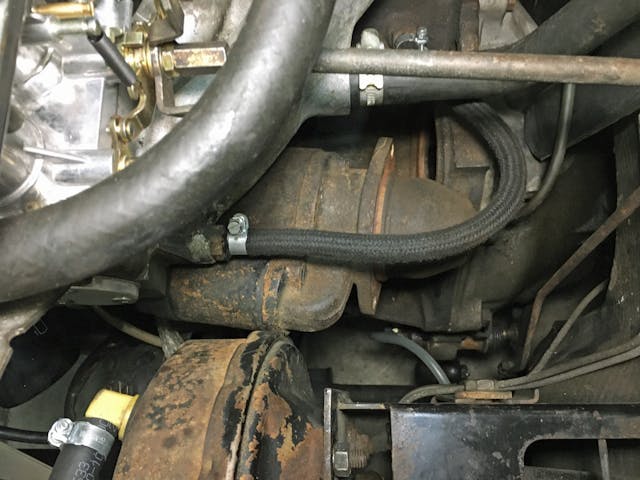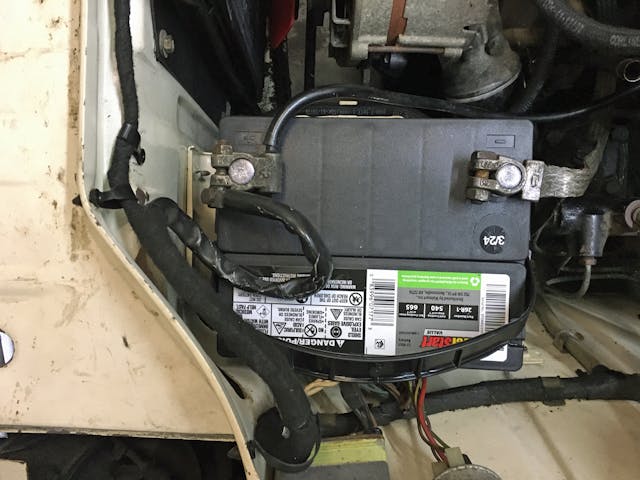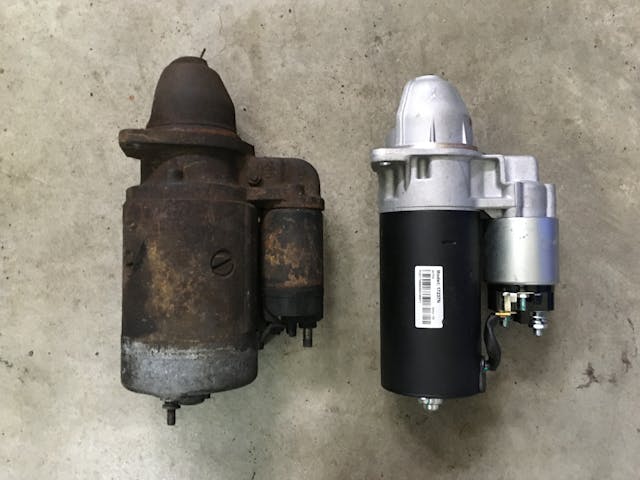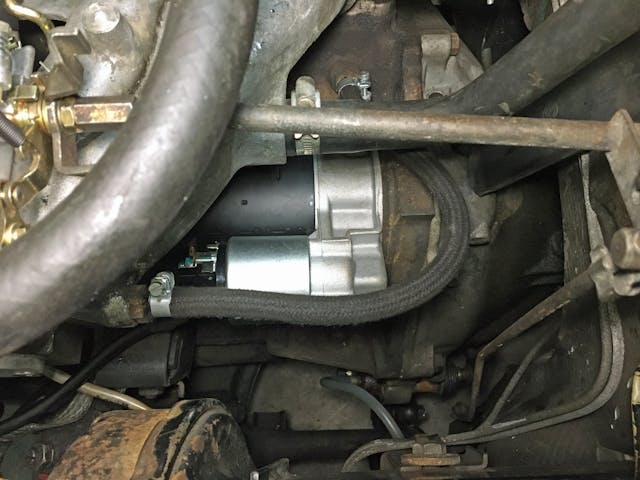Media | Articles
Getting a No-Start Diagnosis Wrong
Back in February, I wrote about troubleshooting a no-start condition. It was, I thought, a useful piece that walked you down the decision tree that delineates car-won’t-crank, car-cranks-slowly, and car-cranks-quickly-but-won’t-start problems, and tells you how to test for each and which component is likely bad.
However, I didn’t delve deeply enough into the issue that a weak battery and a weak starter motor can mimic one another. How do I know? Because I just got bitten by it.
Here’s the deal. As I said in the no-start story, what cranks the engine is the battery, the starter, the cables connecting the two, and the ignition switch that feeds 12 volts to the starter solenoid. If you turn the key and hear weak cranking or nothing at all, the first thing to do is check the voltage at the battery with a voltmeter—that’s exactly what AAA will do if you make a service call. A fully-charged battery should read 12.6 volts, and for every 0.2 volts it drops, it loses about 25 percent of its capacity, so by the time it reaches 12 volts, it’s fully discharged. So if you check the battery voltage and find it’s 12 volts or lower, you’ve definitely found the problem. Or at least you’ve found a problem; you still need to find out why the battery is discharged. If it’s winter, the battery is five years old, and the terminals are badly corroded, replace it. Done. If it was drained because you left the dome light on, recharge it, see if it’s OK, and don’t do that again. But if it’s drained because the alternator wasn’t keeping it charged, the charging system needs to be repaired or the same thing will happen to the new battery.
However, if the battery is fully charged but the engine cranks slowly, the problem is a little harder to diagnose, as it can be caused by the battery (it’s possible for an old battery with sulfated plates to take a full charge but not be able to deliver sustained cranking) or by the starter motor going bad. In my first story, I wrote:
“If the battery posts are clean and the ground paths are good but, even once the battery is recharged, it still won’t crank the car, or only does so for a short amount of time, you can use a battery analyzer that uses resistance as a measure of battery health. I’ve found they work pretty well. But really, the gold-standard test is to remove the old battery, clean the clamps, and install a new or a known-good battery. If the car then cranks and starts, the battery was the problem. Note that, particularly in winter, due to low temperatures sapping battery strength and corrosion on the battery terminals causing high resistance in the contact with the jaws on the jumper cables, the failure of a car to crank with a jump-start can be highly misleading. Time after time I’ve experienced no-crank conditions that vanished immediately when a good battery was dropped directly into the car.”
Later in the piece, I added: “If you’re certain that the battery and the current paths are good, and the starter won’t spin or sounds labored, and it’s hot to the touch, odds are that the starter has reached the end of the line.”
Marketplace
Buy and sell classics with confidence
The idea here is that it’s waaaay easier to replace a battery—or at least to drop in a known good one—than it is to replace a starter, so first you rule out the battery and cables, and if slow-cranking persists, then you look at the starter.

I just was faced with this. And I got it wrong. Here’s how.
My 49,000-mile survivor 1973 BMW 2002—the one I call “Hampton”—has had a longstanding hard-starting problem. Whenever I think I’ve solved it, a few weeks later the problem rears its ugly head and laughs in my face. Cranks-but-won’t-start problems are tough on batteries, especially when the battery in the car is some off-brand “EconoPower” battery that’s sat all winter—disconnected, but not on a trickle charger (too many cars, not enough chargers). So it didn’t surprise me when, during trouble-shooting the hard-starting problem, I cranked long enough to hear the characteristic sound of slower and slower cranking that’s characteristic of running the battery down.
I recharged the battery overnight, came back in the morning, and the car fired right up. This had little to do with the battery and more to do with the intermittent nature of the hard-starting problem, which I still haven’t gotten to the bottom of. But a few days later, the hard-starting was back, and repeated cranking again became slower and slower. I again recharged the battery overnight, and in the morning still had the same set of problems.
As I mentioned previously, I have one of those resistance-based battery testers—a CenTech that I bought at Harbor Freight about 10 years ago. My experience with the tester has been positive—charge the battery, put the tester on it, and if it shows that the resistance across the terminals is less than 5 milliohms, the battery is fine. If it’s over 10 milliohms, the battery is bad, meaning its ability to hold a charge is severely diminished. If it’s somewhere between 5 and 10 milliohms, it’s a gray area, as was the case when I was testing the battery on my 95-year-old neighbor’s car last winter.
I used the CenTech tester on Hampton’s battery, and the reading was below 5 milliohms, indicating that the battery was good. However, it seemed to me that the battery was clearly not holding a charge, and besides, it was a five-year-old value-priced battery, so my conclusion was that my 10-year-old moderately-priced Harbor Freight battery tester had gone bad (shocking, I know).

BMW 2002s take a group 42 or group 47 battery, both of which are on the small side by modern standards, but the 2002tii has less room for the battery due to its larger brake booster, so it takes a tiny little group 26R battery. Since I own three 2002s, one of which is a tii and one of which is a modified car with a tii braking system, and since the Group 26R also fits the Lotus, using 26R batteries in all of them makes sense to me. An EverStart Value Group 26R battery was only $69 at WalMart, so I picked one up. (True story: The guy behind me in line asked me how long that little battery lasted for my trolling motor. He seriously didn’t believe me when I told him that it was the correct battery for an early ’70s German sports car.) Since it had been sitting on the rack for an unknown amount of time, I put it on charge in my garage overnight.

That morning, I yanked out the old battery and dropped in the new one. Imagine my surprise when I found that the same thing happened—the car cranked but didn’t start, and with each turn of the key it cranked slower and slower.
What the?
As you’ve undoubtedly guessed, the problem was the starter motor, not the battery. I hadn’t ever checked the starter by putting my hand on it because it seemed so obvious to me that the battery was the problem. And I hadn’t done the “drop a known-good battery into the car” test because neither of the other 2002s nor the Lotus, with their little Group 26R batteries, are here at the house. I would’ve had to have muscled the larger battery from either of the two other cars in the garage (my 3.0CSi or M Coupe), and with my back issues, I really avoid lifting batteries out of their recessed trays unless they’re dead and need to be replaced. The irony was obvious—by not thoroughly testing, I yanked a still-good battery and muscled an unneeded new one off the rack, into my trunk, into the garage, and into place. Really, it’s a wonder y’all believe anything I say.
So. Bad starter. OK. Fortunately, I had a brand-new starter motor in the garage, one of the smaller, lighter, inexpensive Chinese-made gear-reduction starters that became all the rage for installing into vintage BMWs a number of years back. I installed it, and Hampton’s engine spun like the dickens.

And then I remembered why I had this new starter sitting in a box in the garage. Years back, when I thought that Hampton’s 49,000-mile, one-owner survivor vibe was going to rain money on Bring a Trailer, in preparation for listing the car I did a compression test and found that the repeated cranking caused the starter to slow, which resulted in lower compression readings. Of course, when you’re selling a car, low compression readings are bad, so I bought the $90 gear-reduction starter, installed it, did the compression test, photographed the readings, and then reinstalled the original starter, as I thought it better fit the car’s original survivor vibe. I never interpreted the symptoms as the starter slowly dying. It was just old and a little slow, like me. And then I completely forgot about this little episode.

I’d tell the larger story of Hampton’s hard-starting problem, but it’s still a work in progress. On the positive side, I’m almost positive that it’s not the battery or the starter.
***
Rob’s latest book, The Best Of The Hack Mechanic™: 35 years of hacks, kluges, and assorted automotive mayhem is available on Amazon here. His other seven books are available here on Amazon, or you can order personally-inscribed copies from Rob’s website, www.robsiegel.com.
Check out the Hagerty Media homepage so you don’t miss a single story, or better yet, bookmark it. To get our best stories delivered right to your inbox, subscribe to our newsletters.









Enjoyed the part about the shrinky-dinky 26R battery. Daughter’s 2nd gen CR-V also suffered from dinky battery syndrome. Group 51R was the spec’d battery from Honda. Many owners replace them with Group 24 batteries with Odyssey trays and covers, as did I. Part of the problem stems from key-on operation for too long before starting the engine. If the HVAC is in A/C or defrost mode, the condenser/radiator fan runs continuously, as well as the compressor clutch coil, killing the battery in short order.
Also looking forward to the solution to the intermittent starting issue.
Another hack tip for diagnosing slow crank issues: after attempting to crank for a bit put a hand on all the components. A hot spot is a location of high resistance; warm cables indicate high current into a heavy load….Rob use your creativity to devise an excuse for not trying an inversion table that DUB6 and I haven’t heard yet. Or prepare to be nagged whenever you mention your back. In a friendly way 🙂
Fully agree! I chased these very same problems for almost a year in my ’90s SAAB until I happened to touch the positive cable which turned out to be VERY warm. Battery cables are made up of stranded wire, and it turns out that many of the strands were broken causing high resistance which obviously creates heat. New cable, no more problems. Check the easy stuff first!
Friendly, AND attempt-to-be-helpful…
Yes, I forgot my own advice in the won’t-start troubleshooting tree about laying hands on the components to check for draw. D’oh!
Power wash that nasty looking old starter, disassemble and polish the commutator with emery cloth and replace the bushes if you can – the springs holding them against the commutator have probably lost their spring or are fully extended, and I bet it will work just fine. Assuming the bearings are okay. I bet the area around the brushes are completely full of conductive dust from the worn down brushes.
Man, there’s some old-school advice right there. It’s been a minute since I heard someone advise to “change brushes” in a starter and “clean the commutator” – mostly nowadays it’s “take the starter in if they want a core, but no matter what, buy a new one”. Good on ya, John D!
When I bought my 2011 335i with 89,000 on the clock, it had the original battery in it and was always a slow crank. A year later I had the battery replaced because of other issues, but it did not fix the slow crank problem.
Another year later it was in the shop (that replaced the original battery) for water pump replacement and they mentioned that the battery needed to be replaced! I declined.
Six months later I get a no crank while sitting in the Home Depot parking lot. Since it is a manual, I was able to bump start it and get it home.
I went ahead and replaced the starter, belts and oil filter gasket. My slow crank problem is gone! Now it brings a smile every time I hit the start button and the motor spins rapidly and starts.
Doing simple voltage drop testing on the entire starting circuit is a good way to identify concerns, and remember, resistance changes with heat.